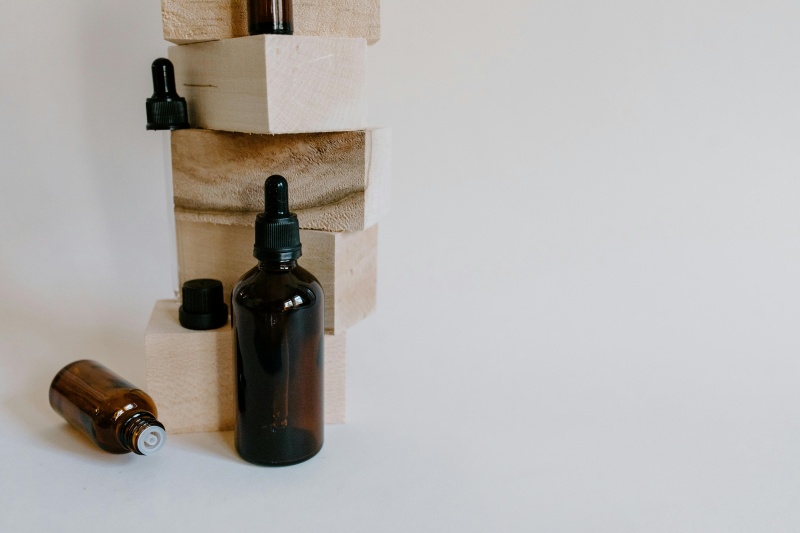Natural personal care brands are taking notice of the remarkable qualities of mānuka oil and tea tree oil–two exceptionally beneficial oils, each with their own unique healing properties.
Mānuka oil, which is expected to become a significant player in the personal care industry with projected sales in the multimillion-dollar range by 2030, combined with the well-known tea tree oil, creates a compelling, comprehensive antimicrobial formulation that has a wide range of applications in therapeutics, skincare, and consumer products.
These applications encompass antiseptic solutions for addressing cuts, scrapes, and wounds, treatment for acne and rosacea, chemical-free mouthwash, natural deodorants, hair and beard care products, dandruff treatment, as well as skin and surface sanitisers, among a host of others.
Mānuka Oil and Tea Tree Oil Differences

Left: mānuka plant; Right: tea tree leaves
Numerous distinctions exist between the two oils, with a few noteworthy ones outlined below:
Antimicrobial Efficacy
- Mānuka oil demonstrates enhanced effectiveness against Gram-positive bacteria.
- Tea tree oil, on the other hand, exhibits greater efficacy when dealing with Gram-negative bacteria.
Harvesting Method
- Tea tree oil is obtained by clearing the plant down to the ground during harvest.
- In contrast, manuka oil is harvested in a manner resembling hedge trimming.
Distillation Duration
- The distillation process for manuka oil is particularly longer, spanning 5 hours, compared to the relatively shorter 2-hour duration required for tea tree oil.
Origins and Traditional Uses
Mānuka oil is distilled from the leaves of Mānuka trees (Leptospermum scoparium), commonly found in New Zealand, particularly the East Cape region, and parts of Australia.
Tea Tree oil, on the other hand, is derived from the leaves of Tea Trees (Melaleuca alternifolia), which are native to Australia.
Both oils have a rich history of traditional use among indigenous populations for treating a wide range of ailments, including burns, wounds, skin infections, sore throats, and more.
Chemical Composition
The composition of an essential oil depends on its chemical composition, known as its chemotype. Essential oils are renowned for their rich terpene compounds, which are responsible for their health benefits and aromas.
Mānuka oil, for instance, possesses a warm, slightly spicy, and floral scent attributed to its predominant sesquiterpene fraction. In contrast, tea tree oil exhibits a more camphor-like and herbaceous aroma, owing to the monoterpene terpinen-4-ol.
New Zealand’s Mānuka trees present a fascinating diversity, with at least 11 distinct chemotypes identified (Douglas et al., 2004). The triketone levels within mānuka oil can vary significantly across different regions of the country. Of particular interest is the high triketone chemotype, a globally unique variant found exclusively in the East Cape region of New Zealand.
This high triketone chemotype owes its exceptional broad-spectrum antimicrobial properties—the ability to inhibit the growth and combat bacteria, viruses, and fungi—to naturally occurring b-triketone compounds like flavesone, leptospermone, iso-leptospermone, and grandiflorone.
East Cape mānuka oil holds exceptional triketone content, exceeding 20% and sometimes reaching as high as 33%. Additionally, it contains sesquiterpenes such as calamenene, b-caryophyllene, and cadinene, which are responsible for potent anti-inflammatory, antioxidant, and anti-aging properties (Matthew et al., 2020).
In the Marlborough Sounds region of New Zealand, mānuka trees also exhibit relatively high levels of b-triketones, ranging from 15% to 20%. On the contrary, mānuka oil derived from trees in other New Zealand regions typically contains less than 5% b-triketones. Mānuka oil originating from Australian Mānuka trees lacks b-triketones altogether (Brophy et al., 1999).
Tea tree oil, in contrast, is characterised by six main chemotypes (Padovan aet al., 2017). Among these, the terpinen-4-ol chemotype is highly valued for its medicinal properties, featuring antimicrobial and anti-inflammatory attributes. As a result, breeding programmes for tea trees focus on optimising terpinen-4-ol content, aiming for levels between 30% and 40%, while reducing concentrations of 1,8-cineole and d-limonene.
Another study by researchers from the University of Hamburg in Germany determined that the bactericidal effectiveness of tea tree oil experiences a substantial enhancement when it is combined with the beta-triketones found in mānuka oil. This synergistic effect is particularly pronounced against four distinct bacteria, namely Staphylococcus aureus, Pseudomonas aeruginosa, Escherichia coli, and Moraxella catarrhalis.
Combining Mānuka Oil and Tea Tree Oil
In conclusion, mānuka essential oil and tea tree essential oil are both acknowledged for their potent antimicrobial, anti-inflammatory, and wound-healing capabilities.
Combining mānuka oil and tea tree oil results in a synergistic blend with various benefits, including enhanced antimicrobial activity against different types of bacteria, fungi, and viruses.
A mild solution consisting of diluted mānuka oil and tea tree oil can be used to cleanse and alleviate skin blemishes and irritations.


